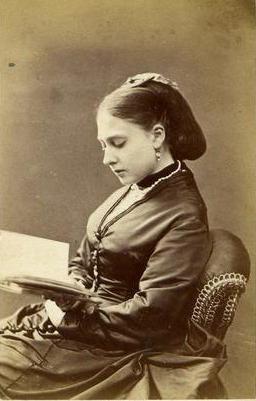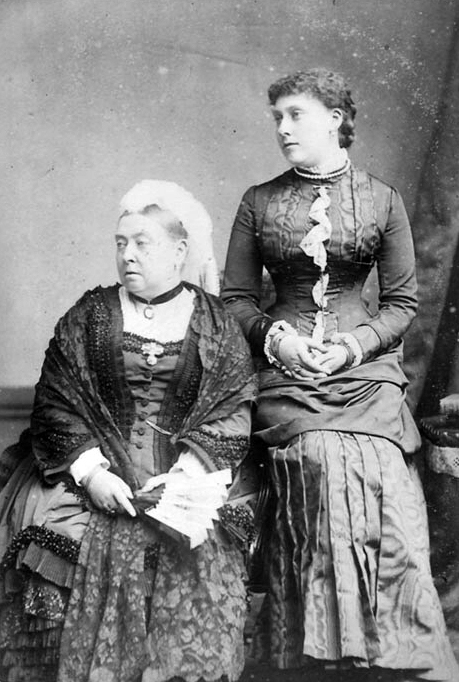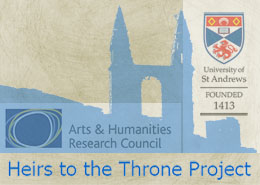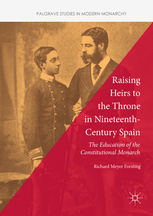The Duties of a Daughter-Cum-Editor 
Jennifer Henderson Crane
On the 193rd anniversary of her great-great grandmother’s birth, 24 May 2012, Queen Elizabeth II made Queen Victoria’s journals available online. The welcoming page notes that the journals were the first digitalised documents belonging to the Royal Archives to be made available online. In a special message by the current sovereign, Queen Elizabeth II states that she hoped this project will “…enhance our knowledge and understanding of the past.” This, as this essay will show, was an interesting choice of words.
Queen Victoria began her journals in the late summer of 1832 when she was thirteen; they conclude approximately a week before her death at eighty-two in January 1901. Nearly every day is accounted for, though there are exceptions as, for example, during her confinements with each of her nine children—entries resumed roughly six weeks after the child’s birth. Despite these occasional interruptions, Victoria’s journals are still lengthy. In her work on Albert Edward Prince of Wales, the future Edward VII, Jane Ridley estimated that, along with her avid letter-writing, the Queen wrote sixty million words during the course of her reign. But the focus here will not be on an examination of Victoria’s journals per se but, rather, the editing process performed by Princess Beatrice.
Beatrice was the Queen’s literary executor and, as such, it was her responsibility to carry out her mother’s wishes with regards to editing the journals. If Victoria had any doubt as to whether her daughter would fulfil her orders diligently, she need not have worried. Since Beatrice finished her editing assignment numerous historians have lamented that the original content has been decimated; indeed, the Princess’s work obliterated rich details, excising passages that may have added more colour and life to this account of her mother’s reign, as well deleting information on numerous others who filled her court and foreign courts as well.
Beatrice’s position of editor, a job she undertook very seriously, filled nearly half of her life, and has triggered controversies over “ominous omissions”—what did she hide? This has lent considerably to the mystery surrounding Victoria’s relationship with her Scottish servant, John Brown, a mystery that persists to the present day. Very luckily for historians, however, a selection of Victoria’s journals survive in her own hand; additionally, other transcribed versions remain untouched. These are significant; not only have they been saved from Beatrice’s hands, but, more importantly, they can be compared with Beatrice’s edits. In this we are allowed a glimpse to what the Princess sought to expunge from the gaze of posterity.
Born Beatrice Mary Victoria Feodore on 14 April 1857, Beatrice’s birth, like that of her elder brother Leopold, had been assisted by what Victoria called, “that blessed chloroform.” As the child of the sovereign, Princess Beatrice was technically an heir, but there was not any chance of her ever ascending the throne. Barring any catastrophic series of events eliminating her four brothers and their children, and then her four elder sisters and their children, there was in reality no possibility of her becoming queen. Known as Baby for years, Beatrice became her mother’s pet. Following Prince Albert’s death in December 1861, so the story went, Victoria clutched Baby to her, and had the young princess was finely bedecked in the finest mourning attire.

Victoria’s five daughters (Alice, Helena, Beatrice, Victoria and Louise); photographed by William Bambridge
Once Beatrice reached marriageable age, Victoria shut her ears on the subject, wishing her youngest child to remain with her as her companion. This did not go to plan. According to her biographer Matthew Dennison, when told of her daughter’s plans, Victoria refused to speak with her for seven months, and took instead to pushing notes across the table. Beatrice wed Prince Henry of Battenberg on 23 July 1885 but this was only allowed with the caveat that the couple would live with the Queen. The marriage produced four children: Alexander, Victoria Eugénie (‘Ena’), Leopold, and Maurice; Ena later became Queen of Spain upon her marriage with King Alfonso XIII in 1906. Sadly, widowhood came all too soon to Beatrice. Prince Henry, having gone to serve Britain in the Anglo-Asante War, was sickened by malaria and died on 22 January 1896.
To the consternation of advisors and the Prince of Wales, Beatrice became her mother’s unofficial secretary and, as the Queen’s sight dimmed as a result of cataracts, she became her hands and eyes as well, writing as Victoria dictated letters as well as her journals. Even before Prince Henry’s death, the Queen’s vision problems were cause for concern amongst her doctors. Two of her physicians, Sir James Reid (1849-1923) and Sir William Jenner (1815-1898) corresponded on the matter, with Reid writing that, “The Queen’s defective eyesight is now a serious hindrance to her writing letters.” Ill feeling about the Princess’s position was not withheld. Frederick ‘Fritz’ Ponsonby (1867-1935), Victoria’s private secretary, was aghast at her access to delicate government issues; the situation he wrote no doubt echoed the opinion of others: “When her [Victoria’s] sole means of reading dispatches…debates, etc, lies in Princess Beatrice, it is simply hopeless.” While not everyone agreed, she was, to all intents and purposes, her mother’s only choice for literary executor.
It is a fair question to ask: why Victoria may have wanted her journals edited following her death? Did she wish to cover conspiracies? Were there scandals she hoped to hush up? These questions are only further intensified when combined with the fact that, after completing her editing, Beatrice destroyed the original journals. Perhaps one of the biggest scandals connected to what Beatrice is said to have erased concerns the precise nature of her mother’s relationship with her Scottish servant, John Brown. Brown (1826-1883), who became a ghillie for the royal family during Prince Albert’s lifetime, made himself indispensable to the Queen in the early years following Albert’s death.
Rumours did not take long to surface; this is evident by reports printed by the Swiss newspaper Lausanne Gazette which claimed Brown and the Queen had married and she was already carrying his child. Tales of the Victoria’s supposed second marriage are still printed today. An article from the Daily Mail, published on 25 February 2012, pointed to a story originally from The Oldie Magazine which claimed there was proof of the rumour. Oldie’s source of the story came from Sir John Julius Norwich, the second Viscount Norwich. According to the Daily Mail, Norwich, born in 1929, asserted that a marriage certificate citing the union between Victoria and Brown had been discovered within the Royal Archives by his friend, Sir Steven Runciman (1903-2000). Runciman showed it to the Queen Mother, who promptly burned it in order to save the royal family from embarrassment. The article also details stories of the children Victoria supposedly had with Brown, again citing Runciman as the source. However extraordinary the claims, though, this same article also confesses that Sir Steven was not always a reliable historian. This also brings to mind more practical matters. The time period when these events were meant to take place was approximately in the mid to late 1860s just when Victoria was nearing her fifties. It is safe to say her fertility at that time would have been highly questionable.
Another story linked with Beatrice’s work targets one of the Queen’s children, her fourth daughter, Princess Louise. Born in 1848, Louise is remembered best today for her exceptional artistic talents. One of her best known sculptures is now the most visible: the white statue of Queen Victoria outside the gates of Kensington Palace. Historian Lucinda Hawksley, though, believes there are darker secrets to Louise’s life, which is the focal of her biography, The Mystery of Princess Louise. According to Hawksley, Louise had an affair during her teenage years which resulted in the birth of an illegitimate son. Concrete details relating to this were not shown to researchers in the Royal Archives, though, and also erased from the Queen’s journals. However tantalising the stories—including that of Louise being in the arms of her lover when he died—the book offers little in the way of source material, relying instead heavily on the limited access to the Archives at Windsor Castle and the Queen’s censored journals. As with the Queen and John Brown, whatever the truth regarding Louise’s relationships, and whether or not she indeed bore a child, the real answer cannot be conjectured through the remaining evidence.
The extent of Beatrice’s editing will not be entirely known with any precision as the surviving transcripts of Victoria’s writing end on 16 February 1840, a week following her marriage to Prince Albert. The journals in Victoria’s own hand cover the years from August 1832 until 1 January 1837, the year she became queen. One of the best examples of Beatrice’s editing, and one cited by numerous historians, is the entry the morning after her and Albert’s wedding. In the transcriptions provided by Lord Esher, Reginald Brett (1852-1930), the entry began: “11th February, When day dawned (for we did not sleep much) and I beheld that beautiful angelic face by my side, it was more than I can express! He does look so beautiful in his shirt only, with his beautiful throat seen.”
She continued to write on having breakfast, taking walks together, and the various personages to whom she wrote, and concluded with details about the dinner that night and who was present. The opening to Princess Beatrice’s version was exceedingly different: “After a nice little breakfast together, I wrote to Mama from whom I had a kind letter…” Gone were all the specifics of Victoria’s seeing her bridegroom the morning after their wedding that revealed the intimacy which the bride described in such gushing words. Stricken also were the attendees at their dinner, and particulars that made up their first married day together. Victoria’s words revealed her emotional state, while her daughter’s version offers a comparatively basic recap of events.
The entry the day of wedding is also telling. Beatrice transcribed that Victoria “Slept well & breakfasted at ½ p. 9, before which Mama came, bringing me a nosegay of orange flowers, & good Lehzen gave me a little ring.” The original version went like this: “Monday, February 10, The last time I slept alone. Got up at a ¼ to 9 and having slept well; and breakfast at ½ p.9. Mama came before and brought me a Nosegay of orange flowers. My dearest kindest Lehzen gave me a dear little ring.”
Not only are there difference in the opening of both versions, but in the endings as well. Beatrice’s recounting that the Queen felt unwell that night, and that Albert stayed with her the whole time where she thanked God for the blessing she had in Albert and how she endeavoured to be worthy of him. Once again, Victoria’s own words display the closeness and intimacy she already felt towards in her husband: “…we both went to bed; (of course in one bed), to lie by his side, and in his arms, and on his dear bosom, and be called by names of tenderness, I have never yet heard used to me before – was bliss beyond belief! Oh! this was the happiest day of my life! – May God help me to do my duty as I ought and be worthy of such blessings!”
While it may be understandable that Beatrice chose to excise the details disclosing her parents’ physical intimacy, it may be questioned why she chose to rephrase her mother’s words regarding Lehzen. Johanna Clara Louise Lehzen, born in 1784, had been Victoria’s governess and rose to become her confidante. Though adored by her charge, Lehzen was loathed and distrusted by others because her influence on Victoria. Later a Baroness, she and Prince Albert would cross swords over the issue of the royal nursery where she ultimately found herself the loser.
Another matter that may have come into play with her Victoria’s description of her “dearest kindest Lehzen” was the issue of fraternization. It may well be that she did not consider her former governess to be a servant, but that is not to say that Beatrice felt the same. Lehzen, in the most practical sense, had been a servant of the family to help educate the then young Princess Victoria as well as a, for lack of a better term, a babysitter. Beatrice’s edition of “Good Lehzen” implies approbation upon a servant; Victoria’s endearment reveals a far closer relationship as shown in token for, in Victoria’s words, “the dear little ring.”This editing of Victoria’s relationships with her servants may also cover the entries relating to John Brown. The Queen could not be read as having such personal ties with those meant to serve her. Entries that had referred to servants by name were replaced with generic terms. Identities were whitewashed, and the Queen remained above her servants.
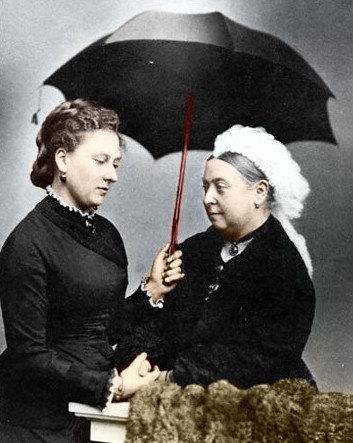
Princess Beatrice in mourning with Queen Victoria (coloured from black and white photo). Photograph by W. & D. Downey, colourization by Peter Symonds.
It has been estimated by Robin Macworth-Young that Beatrice removed roughly two-thirds of the original text from her mother’s journals. Whatever the contents may have been, scandal fodder or not, they continue to elude historians. While she is routinely condemned for her work, not all believe Princess Beatrice should be so treated. Jane Ridley offers a kinder assessment, pointedly writing that the Princess was following her mother’s wishes. Ridley also believes that it is entirely possible that had the Queen left them to her son Bertie, Edward VII, he would have had them destroyed without any transcription, whether edited or not. The question remains, though, on why Victoria wanted her journals edited. The Queen was no fool. She knew that, as sovereign, her writings would attract much attention—and very possibly exploitation as well. When she began her journals, she did so with the understanding that her mother and Lehzen would read whatever she noted down.
Later, as Queen, she was fully cognizant of the importance attached to her personal writings. It may be argued that, giving Beatrice the task of editing her journals following her death, afforded Victoria a degree of safety. If pieces of her writings were not to offer the level of discretion that was required, she was assured that Beatrice would excise anything deemed too personal and private, and anything not to be shared with anyone other than the royal family. It is also very likely that she may have felt that aspects of the Queen’s private life were not vital in saving. Beatrice did not record her personal involvement in editing her mother’s journals, so all her own thoughts and opinions on what she chose to ignore or rewrite has been lost.
Beatrice’s position, often scorned and lamented, was not an easy one. Her mother held a tight grip on her from her earliest years, and resented her daughter’s intention to marry. As Victoria’s health declined, so her need for her youngest child grew. Her last task for Beatrice inevitably led to an unfair assessment and reputation. While it cannot be denied that her editing irrevocably lost much to history, perhaps it would be best to close on what Robin Mackworth-Young thought: Queen Victoria was perfectly entitled to do what she chose with her most private and intimate writings, and we can count ourselves lucky that they have been left to posterity in any form at all.”
Suggested Further Reading:
- Dennsion, Matthew, The Last Princess: The Devoted Life of Queen Victoria’s Youngest Daughter (Phoenix, 2008).
- Mackworth-Young, Robin, The Royal Archives, Windsor Castle, Archives, vol. 13 (1978)
- Packard, Jerrold, Queen Victoria’s Daughters (St Martin’s Press, 1998).
- Queen Victoria’s Journals: http://www.queenvictoriasjournals.org/home.do
- Thornton, Michael, “Victoria’s Secret?”, http://www.dailymail.co.uk/femail/article-2106204/Victorias-secret-According-tantalising-new-evidence-Queen-Victoria-married-Scottish-groom-bore-secret-daughter-spirited-America.html#ixzz3qDfNPowf

